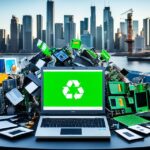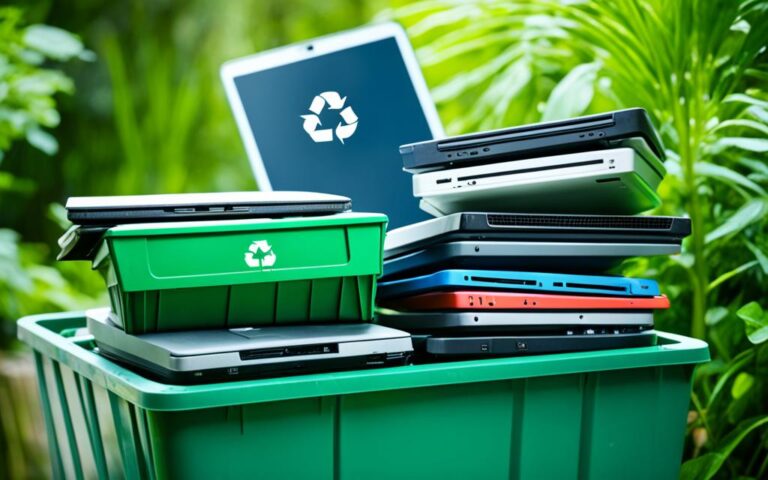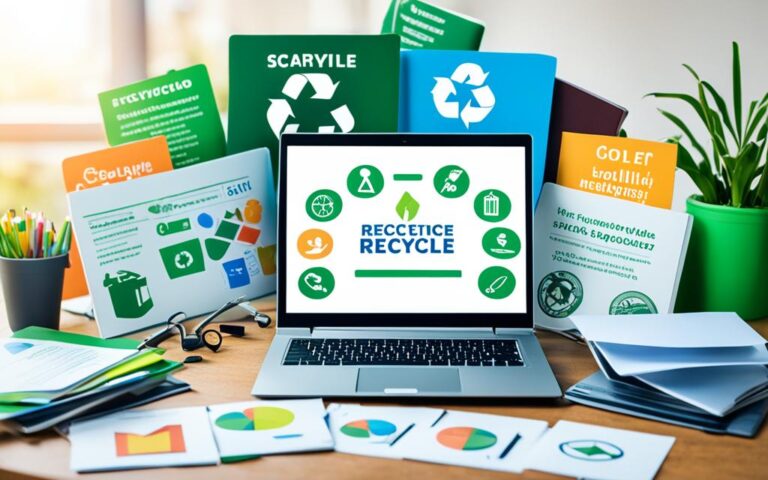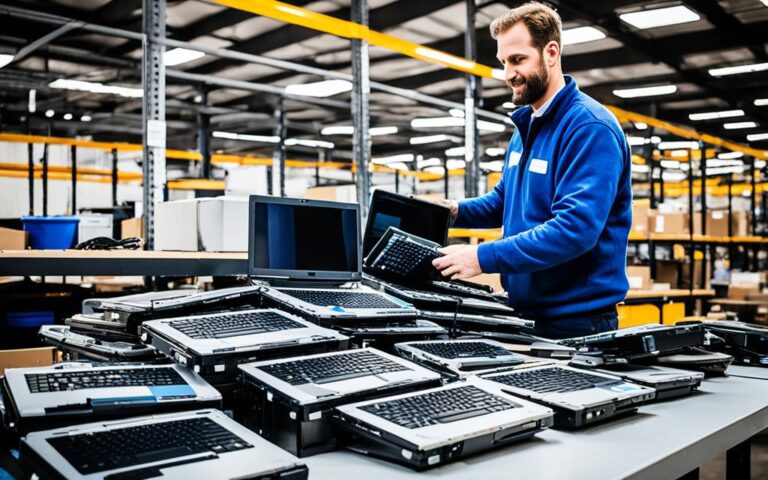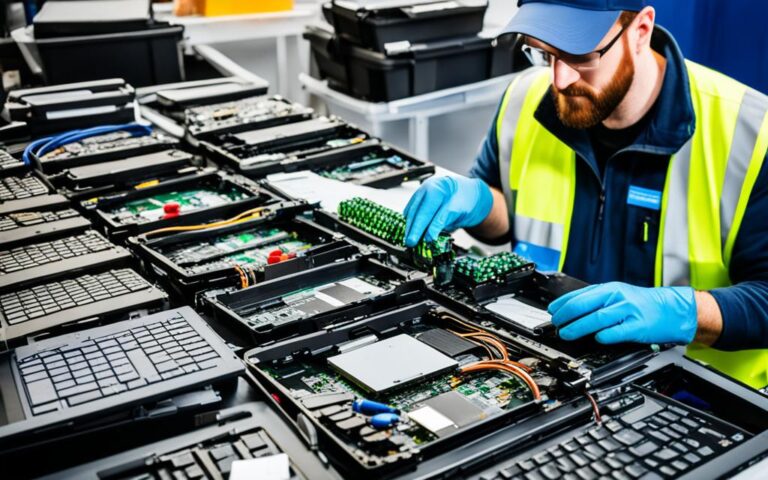Laptop Recycling: Bridging the Gap Between Old and New Technology
In today’s digital age, access to technology and the internet is crucial for economic, educational, and social opportunities. However, not everyone has equal access, leading to a digital divide. Additionally, the rapid growth of electronic waste poses environmental and health risks. IT recycling plays a vital role in bridging the digital divide and managing e-waste sustainably. It provides affordable technology, promotes digital inclusion, and reduces the strain on landfills. Cooperation between businesses, governments, and civil society organisations is essential in creating a more inclusive and sustainable digital future.
As technology continues to advance at a rapid pace, older devices often become obsolete, resulting in electronic waste. Laptop recycling is a solution that not only helps the environment but also bridges the gap between old and new technology. By recycling and reusing laptops, we can extend their lifespan and provide affordable access to technology.
The technology gap is a significant challenge in today’s society. Many individuals and communities, particularly those from disadvantaged backgrounds, lack access to up-to-date technology and the internet. This digital divide exacerbates existing inequalities in education, employment, and social engagement. By focusing on laptop recycling initiatives, we can address this gap by refurbishing and offering affordable devices to those in need.
Recycled laptops not only provide access to technology but also promote digital inclusion. With access to laptops, individuals can engage in online education, enhance their skills, and connect with others around the world. By bridging the technology gap, laptop recycling empowers individuals and communities, enabling them to participate fully in our increasingly digital society.
In addition to promoting equal access to technology, laptop recycling contributes to sustainable practices. Electronic waste, or e-waste, is a growing concern worldwide. Without proper disposal and management, e-waste releases toxic substances into the environment, leading to pollution and health hazards. By recycling laptops, we reduce the strain on landfills, prevent environmental damage, and conserve valuable resources.
Furthermore, laptop recycling is a collaborative effort. Businesses, governments, and civil society organisations all play a critical role in driving sustainable practices and promoting digital inclusion. By working together, we can ensure a more equitable and environmentally friendly future.
In conclusion, laptop recycling is a powerful strategy for bridging the gap between old and new technology. It not only provides affordable access to technology but also promotes digital inclusion, reduces electronic waste, and supports sustainable practices. By embracing laptop recycling, we can create a more inclusive and sustainable digital future for all.
Understanding the Digital Divide
The digital divide refers to the inequalities in accessing technology and the internet. Factors such as socio-economic status, education level, and geographical location contribute to this divide. Limited access to technology hinders areas such as education, employment, and social connectivity.
Efforts should be made to address the digital divide through initiatives that promote technology access, digital literacy, and affordable internet services. Bridging this gap is crucial for creating an inclusive society with equal technological opportunities for all.
According to a recent study conducted by the Digital Divide Institute, approximately 34% of low-income households in the UK lack access to essential internet services, while only 5% of high-income households face the same challenge. This significant disparity highlights the need for targeted interventions to ensure equal technology access for all individuals.
The Impact of Inequalities in Technology Access
Education: Limited access to technology in underprivileged communities hampers educational development. Students may struggle to complete online assignments, access learning resources, or participate in remote classes, amplifying existing educational inequalities.
Employment: The digital divide also impacts employment opportunities. Many job applications and recruitment processes now require online access, leaving those without technological resources at a disadvantage. This widens the gaps in employment rates and income levels between different socio-economic groups.
Social Connectivity: The internet has become a vital means of communication and social interaction. Access to online platforms allows individuals to connect with friends and family, access information, and participate in virtual communities. People without technology access face isolation and miss out on the social benefits of digital connectivity.
Initiatives to Bridge the Digital Divide
Various initiatives have been implemented to address the digital divide and promote equal technology access:
- Government Programs: Governments can play a significant role in reducing the digital divide. By investing in infrastructure development, providing subsidies for internet services, and promoting digital literacy programs, governments can ensure that individuals from all backgrounds have equal opportunities to access technology and the internet.
- Non-profit Organizations: Non-profit organizations like Digital Unite and Bigger Picture strive to bridge the digital divide by offering digital skills training, providing affordable devices, and facilitating internet access in underserved communities.
- Private Sector Partnerships: Companies and corporations can collaborate with non-profit organizations and government agencies to fund technology access initiatives. By donating devices, offering discounted internet services, or providing digital skills training programs, the private sector can contribute to bridging the digital divide.
Addressing the Divide for a More Inclusive Society
In conclusion, addressing the digital divide is essential for creating a more inclusive society with equal technological opportunities for all. By focusing on initiatives that promote technology access, digital literacy, and affordable internet services, we can mitigate the inequalities in accessing technology and the internet.
Efforts from governments, non-profit organizations, and the private sector are crucial in bridging the digital divide and ensuring that no individual is left behind in the digital era.
Impact of E-Waste on the Environment
E-waste, including devices like computers and cell phones, is one of the fastest-growing waste streams globally. If not properly managed, e-waste poses dangers to health and the environment. Landfills are not equipped to handle the hazardous chemicals present in e-waste, leading to soil contamination and water pollution. Burning e-waste releases toxic gases and contributes to air pollution. Proper electronic waste recycling is crucial for sustainable waste management, resource conservation, and reduced energy consumption.
Recycling e-waste helps recover valuable materials and prevents environmental damage caused by improper disposal. By extracting and reusing precious metals like gold, silver, and copper from e-waste, we can reduce the need for destructive mining practices and conserve natural resources. Additionally, recycling prevents the release of toxic substances, such as lead, mercury, and cadmium, into the environment, which can contaminate water sources and harm ecosystems.
The following table provides a glimpse into the environmental impact of e-waste:
| Type of Environmental Impact | Causes | Consequences |
|---|---|---|
| Soil Contamination | Improper dumping of e-waste in landfills | Reduces soil fertility and introduces toxic substances into the food chain |
| Water Pollution | Leaching of hazardous chemicals from e-waste | Contaminates drinking water sources and harms aquatic life |
| Air Pollution | Burning of e-waste | Releases toxic gases and contributes to respiratory issues and climate change |
Proper disposal and recycling of e-waste help mitigate these environmental risks. By recycling electronic devices through certified recycling facilities, we can ensure that toxic substances are handled safely and valuable materials are recovered for reuse. Recycling also reduces the demand for raw materials and helps conserve energy, as the production of new electronics requires significant amounts of resources, including fossil fuels.
According to the World Health Organization, improper disposal of e-waste causes significant environmental and public health hazards. Recycling and responsible e-waste management are essential for protecting our planet and safeguarding the well-being of communities worldwide.
By embracing sustainable practices and raising awareness about the importance of e-waste recycling, we can make a positive impact on the environment and create a more sustainable future.
The Role of IT Recycling in Bridging the Digital Divide
IT recycling plays a crucial role in bridging the digital divide. By refurbishing and recycling donated technologies, organizations like Computer Reach provide affordable access to technology, helping to close the gap. Refurbished devices are made available at lower prices, making them accessible to a wider population and promoting digital inclusion and equal opportunities for all.
Furthermore, IT recycling contributes to sustainable practices by reducing landfill waste and preventing environmental hazards. Instead of disposing of electronic devices, recycling them ensures that valuable materials are recovered and reused, reducing the strain on natural resources. By choosing to recycle and reuse technology, we actively contribute to a more equitable and environmentally friendly society.
Benefits of IT Recycling:
1. Affordable Technology: Through IT recycling, refurbished devices become more affordable, enabling individuals and communities to access technology that may have been otherwise out of reach.
2. Reduced Environmental Impact: By diverting electronic waste from landfills, IT recycling helps minimize the environmental hazards caused by improper disposal methods. This includes preventing soil contamination, water pollution, and air pollution caused by burning e-waste.
3. Digital Inclusion: IT recycling promotes digital inclusion by providing equal access to technology. It helps bridge the digital divide by ensuring that individuals from all backgrounds have the opportunity to benefit from technological advancements and participate fully in the digital world.
4. Social Impact: By making affordable technology accessible, IT recycling has a significant social impact. It opens up opportunities for education, employment, and social connectivity, empowering individuals and contributing to overall societal development.
“IT recycling not only provides affordable technology but also creates a more inclusive and sustainable future for all, bridging the digital divide and reducing electronic waste.”
– First source
| Benefits of IT Recycling | Description |
|---|---|
| Affordable Technology | IT recycling makes refurbished devices more financially accessible, allowing individuals and communities to access technology at lower prices. |
| Reduced Environmental Impact | By recycling electronic waste, IT recycling helps minimize the environmental hazards caused by improper disposal, such as soil contamination and air pollution. |
| Digital Inclusion | IT recycling promotes digital inclusion by providing equal access to technology, bridging the gap between those who have and those who do not have access to technology. |
| Social Impact | By enabling access to affordable technology, IT recycling opens up opportunities for education, employment, and social connectivity, enhancing overall societal development. |
Conclusion
Laptop recycling plays a crucial role in bridging the technology gap and promoting digital inclusion. By recycling and reusing electronic devices, we can provide affordable access to technology, ensuring that everyone has an equal opportunity to participate in the digital world. Additionally, laptop recycling contributes to sustainable practices by reducing electronic waste and its negative environmental impact.
Cooperation between businesses, governments, and individuals is vital in implementing sustainable practices and addressing the digital divide. Through initiatives that promote laptop recycling, refurbished devices, and affordable technology, we can create a more inclusive and environmentally friendly digital future.
It is our collective responsibility to prioritize laptop recycling and embrace the principles of digital inclusion and sustainable practices. By taking action today, we can bridge the technology gap, promote digital inclusion, and create a better tomorrow for all.
FAQ
What is laptop recycling and why is it important?
Laptop recycling is the process of repurposing or reusing electronic devices to provide affordable access to technology, promote digital inclusion, and reduce electronic waste. It is important because it bridges the gap between old and new technology, allowing more people to have equal technological opportunities and contributing to a more sustainable future.
What is the digital divide and why is it a concern?
The digital divide refers to the inequalities in accessing technology and the internet. Factors such as socio-economic status, education level, and geographical location contribute to this divide. Limited access to technology hinders areas such as education, employment, and social connectivity. Addressing the digital divide is crucial to create an inclusive society with equal technological opportunities for all.
What are the environmental impacts of e-waste?
E-waste, which includes devices like computers and cell phones, is one of the fastest-growing waste streams globally. Improper management of e-waste poses dangers to health and the environment. Landfills are unable to handle the hazardous chemicals present in e-waste, leading to soil contamination and water pollution. Burning e-waste releases toxic gases and contributes to air pollution. Proper electronic waste recycling is necessary to manage waste sustainably, conserve resources, and reduce energy consumption.
How does IT recycling play a role in bridging the digital divide?
IT recycling, such as the efforts of organizations like Computer Reach, refurbishes and recycles donated technologies to provide affordable access to technology. Refurbished devices can be made available at lower prices, promoting digital inclusion and equal opportunities for all. Additionally, IT recycling helps manage electronic waste sustainably by reducing landfill waste and preventing environmental hazards. By choosing to recycle and reuse technology, we can contribute to a more equitable and environmentally friendly society.
How does laptop recycling contribute to bridging the technology gap?
Laptop recycling plays a vital role in bridging the gap between old and new technology. By recycling and reusing electronic devices, we can provide affordable access to technology, promote digital inclusion, and reduce electronic waste. It is essential for businesses, governments, and individuals to cooperate in implementing sustainable practices and addressing the digital divide. By doing so, we can create a more inclusive and sustainable digital future for all.




